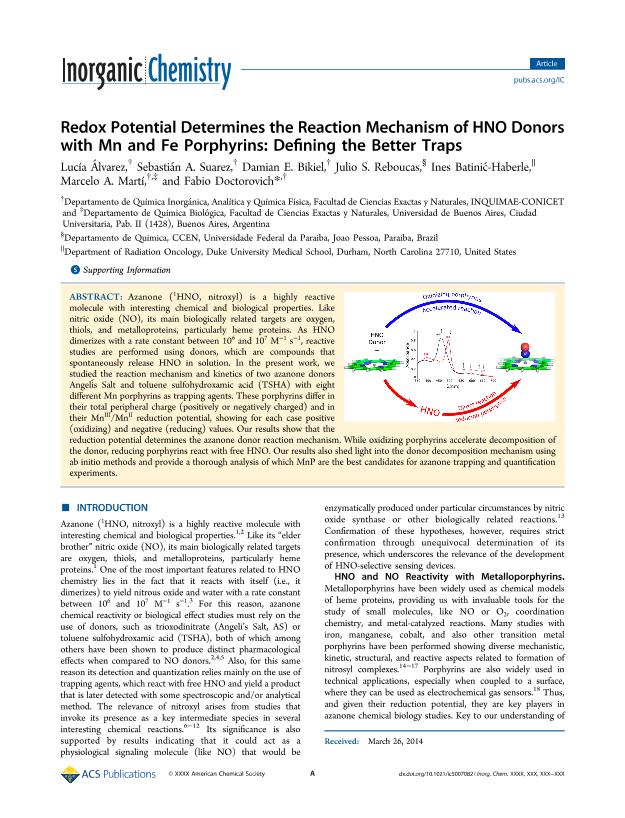Artículo
Redox potential determines the reaction mechanism of HNO donors with Mn and Fe porphyrins: Defining the better traps
Álvarez, Lucía ; Suarez, Sebastian
; Suarez, Sebastian ; Bikiel, Damian Ezequiel
; Bikiel, Damian Ezequiel ; Reboucas, Julio S.; Batini Haberle, Ines; Marti, Marcelo Adrian
; Reboucas, Julio S.; Batini Haberle, Ines; Marti, Marcelo Adrian ; Doctorovich, Fabio
; Doctorovich, Fabio
 ; Suarez, Sebastian
; Suarez, Sebastian ; Bikiel, Damian Ezequiel
; Bikiel, Damian Ezequiel ; Reboucas, Julio S.; Batini Haberle, Ines; Marti, Marcelo Adrian
; Reboucas, Julio S.; Batini Haberle, Ines; Marti, Marcelo Adrian ; Doctorovich, Fabio
; Doctorovich, Fabio
Fecha de publicación:
07/2014
Editorial:
American Chemical Society
Revista:
Inorganic Chemistry
ISSN:
0020-1669
Idioma:
Inglés
Tipo de recurso:
Artículo publicado
Clasificación temática:
Resumen
Azanone (1HNO, nitroxyl) is a highly reactive molecule with interesting chemical and biological properties. Like nitric oxide (NO), its main biologically related targets are oxygen, thiols, and metalloproteins, particularly heme proteins. As HNO dimerizes with a rate constant between 106 and 107 M-1 s-1, reactive studies are performed using donors, which are compounds that spontaneously release HNO in solution. In the present work, we studied the reaction mechanism and kinetics of two azanone donors Angelís Salt and toluene sulfohydroxamic acid (TSHA) with eight different Mn porphyrins as trapping agents. These porphyrins differ in their total peripheral charge (positively or negatively charged) and in their MnIII/MnII reduction potential, showing for each case positive (oxidizing) and negative (reducing) values. Our results show that the reduction potential determines the azanone donor reaction mechanism. While oxidizing porphyrins accelerate decomposition of the donor, reducing porphyrins react with free HNO. Our results also shed light into the donor decomposition mechanism using ab initio methods and provide a thorough analysis of which MnP are the best candidates for azanone trapping and quantification experiments.
Palabras clave:
Mn
,
Fe
,
Porphyrin
,
Hno
Archivos asociados
Licencia
Identificadores
Colecciones
Articulos(INQUIMAE)
Articulos de INST.D/QUIM FIS D/L MATERIALES MEDIOAMB Y ENERGIA
Articulos de INST.D/QUIM FIS D/L MATERIALES MEDIOAMB Y ENERGIA
Citación
Álvarez, Lucía; Suarez, Sebastian; Bikiel, Damian Ezequiel; Reboucas, Julio S.; Batini Haberle, Ines; et al.; Redox potential determines the reaction mechanism of HNO donors with Mn and Fe porphyrins: Defining the better traps; American Chemical Society; Inorganic Chemistry; 53; 14; 7-2014; 7351-7360
Compartir
Altmétricas



